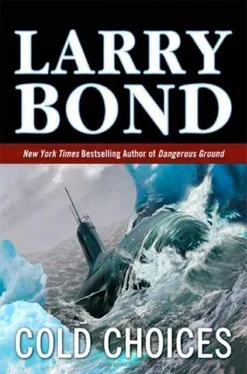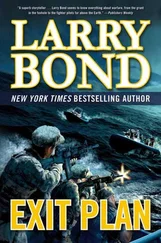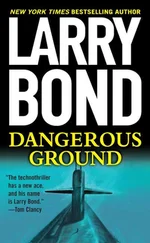Jerry watched the quartermasters update the chart. It was all by dead reckoning at this point, but the chart was still a check on the mental mathematics in Lavoie’s head. The nav plot showed them slightly past their intended position, but only by a hundred yards or so, the length of the boat. Stan Lavoie had the right touch. “Plot shows us on station,” Jerry reported softly. “Distance from planned position is within navigational error.”
“Nicely done, Mr. Lavoie.” Rudel’s praise was always public. Reaching up, he pressed the talk button on the intercom and said, “Sonar, conn, report all contacts.”
“Conn, sonar, only white noise from the ice, sir. Not even biologies.” Sonar would have reported anything, of course, but Rudel’s check was the last step. Since the encounter with the Delta IV, the only other Russian vessels they’d detected had been two distant icebreakers.
Picking up the Dialex handset, Rudel called the torpedo room. “Mr. Palmer, are you ready?” Jerry knew that the captain’s question was also pro forma. Palmer and the torpedo gang had been ready since six that morning, when Jerry had visited the torpedo room before breakfast.
“LaVerne’s loaded in tube four and is ready in all respects, sir.”
“Very well.” Hanging up, Rudel looked at Lavoie and said, “Stan, you have my permission to prepare the tube and launch the UUV when ready.”
“Prep the tube and launch the UUV when ready, aye sir.” Executing a rough facsimile of a pirouette, Lavoie crossed over to the right-hand side of the periscope stand by the fire-control consoles.
“FT of the Watch, flood down, equalize, and open the outer door on tube four.”
While the fire-control tech prepared the tube, Jerry started leafing through a file folder until he found a sheet of tracing paper labeled “LaVerne #3.”
“Sir, tube four is flooded, equalized, and the outer door is open.”
“Stand by. Launch,” Lavoie ordered.
The fire-control technician pressed the firing button and reported, “Tube four fired electrically.”
A moment later, Palmer’s voice reported, “LaVerne’s away. No problems.” There had been no detectable sound in control and only a slight pressure change as compressed air spun up the turbine pump and ejected the vehicle out of the tube.
“Conn, sonar,” called out the sonar supervisor. “We have the UUV’s motor running normally, bearing one two five.” That matched Jerry’s planned course for the first leg of her journey. He laid the tracing paper down on the chart. It showed a back-and-forth lattice of lines, spotted with colored symbols. Timed waypoints marked the end of each path of the search pattern. A faithful robot, LaVerne would follow these lines, programmed into her memory, until she reached the point marked “end,” in a little over forty hours from now.
Captain Rudel walked over to the chart table and watched Jerry lay the plotted track over the chart. “We’ll remain here for another half hour. I want LaVerne well away before we start moving on. I want to make sure the UUV hasn’t been detected.”
Jerry checked the chart. “Understood, sir. Recommended course to Point Hotel recovery position is two eight seven.”
“Mr. Lavoie, you heard the Navigator.” Rudel glanced at the clock. “Get us under way at zero one thirty-five hours on that course. Maintain normal patrol quiet, but have sonar keep a sharp watch to the southeast. I want to know if there’s any reaction at all to the UUV.”
Lavoie nodded, “Understood, sir.” Comfortable with the situation, Rudel left control smiling.
Jerry looked around the quiet, smoothly running control room. “We’re halfway there. I hope the rest of the surveys go as well as the first nine.”
* * *
LaVerne swam away from her launch point at three knots, her slowest and quietest speed. An hour and twenty minutes later, she reached her first nav point. Rising steadily, she quickly reached the surface, raised a small antenna, and listened for the GPS satellites. There were four above the horizon, and LaVerne fixed her geographic position within twenty feet. This would ensure an accurate survey
She dove back into her element, heading for the start of her search grid. The UUV’s most important sensors for this mission were its high-resolution side-looking sonars. They used very high-frequency sound beams to map the seabed. As well as mapping the depth and shape of the bottom, the type of return could hint at the bottom type — rock, sand, mud, whatever. She would store the information until she returned to Seawolf, where the data would be downloaded.
LaVerne skimmed over the seabed at a height of one hundred feet and at a speed of five knots. She had to be high enough off the ocean floor to get the desired swath width. The idea now was to cover as much ground as possible, sweeping an area over a thousand yards wide and fifteen miles long. Each survey zone was a fifteen-by-fifteen-nautical-mile box, and LaVerne would diligently scan almost eighty-five percent of it before returning to Seawolf.
The UUV’s mission was to find places on the seabed suitable for automated acoustic sensors. She had to do it covertly, of course, to avoid alerting the Russians. The Russians, however, had long ago mapped this part of the Barents and more. It had been a simple matter to choose where their buoys would be emplaced.
The Amga autonomous submarine detection system was a heavily modified version of an earlier acoustic warning buoy. The cylindrical body was three feet in diameter and five feet long. The buoy was moored to the bottom, floating about sixteen feet off the seabed. Its only distinctive features were twenty-four three-foot metallic tubes running around the circumference of the cylinder. These were the passive hydrophones, the parts that actually received the sounds. The rest of the cylinder, top and bottom, and even the anchor that held it to the bottom, was coated with rubberized foam that hid it from any active sonar searching the area.
Inside the Amga buoy, a sophisticated computer listened to the ocean around it. Because the Russians were familiar with the area, they knew what sounds were typical: the sounds of ice, the sounds of sea life, even wave slap were stored in the computer’s memory. They also stored the sounds made by a submarine, both Russian subs and other countries’.
The designers had worked hard on the automated signal processing. They didn’t want the buoy sounding the alarm every time it heard something it didn’t understand. In engineering terms, it had to have a “low false-alarm rate.” So it used an intricate series of algorithms to assess the sounds it was hearing. For a contact to be valid, its noise pattern had to meet a majority of the preset conditions.
When LaVerne passed by one of the Russian buoys, it was two thousand yards away. That was close enough for the Russian buoy to hear the noise made by the UUV’s motor, but it wasn’t enough noise to trigger a response. According to the buoy’s electronic brain, this contact didn’t sound right. A submarine would make many different kinds of noises, from the many pumps, motors, and other equipment inside the sub’s hull to the flow of water around the hull, and they would be louder.
On the next pass, LaVerne was on the other side of the buoy, and even closer, but the Russian computer still ignored the UUV. Her mapping sonar swept across the buoy, but LaVerne was programmed to search the bottom. It noted the location of an anomalous fuzzy echo, but took no other action. That wasn’t part of its assigned task.
The two robots, both designed to search, studiously ignored each other as LaVerne worked its way past and away from her stationary Russian cousin.
* * *
Jerry wasn’t the only one watching the fathometer. In these waters, with the charts they had, the OOD, the quartermaster of the watch, even the sonar supervisor kept one eye on the display.
Читать дальше












